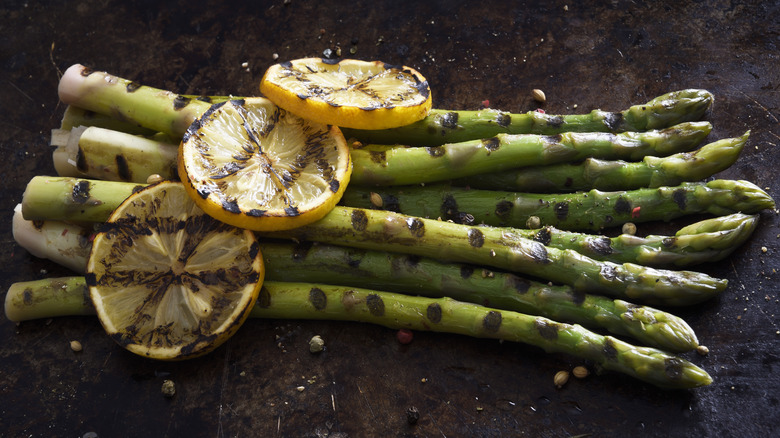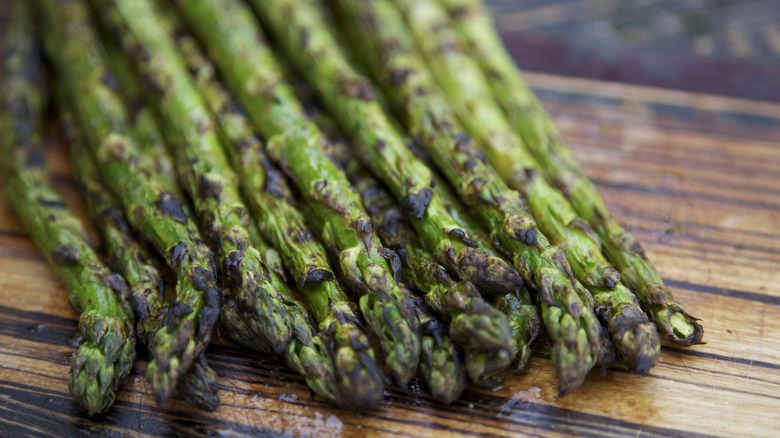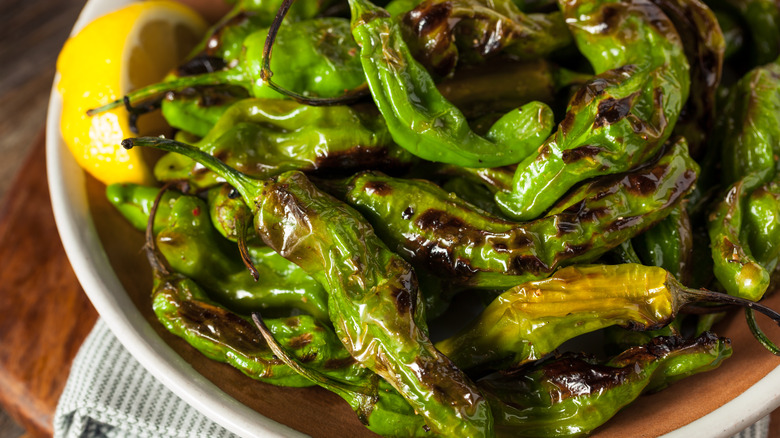If You're Not Dry-Charring Asparagus, You're Making A Huge Mistake
Asparagus is the perfect ingredient to enjoy raw in salads or cooked using various methods such as steaming, sauteing, grilling, or roasting. However, if you want to enhance its flavor and maintain its crisp texture, dry charring is the way to go.
Charring is a popular cooking trend across all cuisines. It creates a beautiful leopard pattern on food, which enhances the flavor and appearance of meat, pizza, fruits, and vegetables. This is achieved by caramelizing the food's natural sugars, adding a smoky layer of flavor. Unlike sauteing or stir-frying, dry charring doesn't require cooking oil, which means no splatters to clean.
There are a few ways to dry-char asparagus; however, it's best to begin on the stove versus an open flame since food can go from charred to burnt quickly. It's the ideal side dish for seared steaks and chops since the asparagus cooks while the protein rests, enabling you to use the same pan, preferably cast iron or carbon steel. Ensuring that the veggies and pan are dry, add a single layer of asparagus in a scorching pan, so each stalk makes contact with the hot surface — resisting the urge to play with them. Char thinner stalks on only one side to prevent overcooking, and flip thicker ones until you reach your desired doneness.
Tips for dry-charring
When dry charring, keep a few things in mind to achieve the best results. Make sure the asparagus is clean and thoroughly dry before cooking. Moisture will produce steam and prevent its surface from charring. Similarly, if you are reusing a pan, it's essential that it's free of oil. Cooking at high temperatures will cause fats to smoke, setting off a chain of unpleasant noises and smells.
As mentioned earlier, cast iron or carbon steel pans are a good idea — but we also want to caution you against using a coated nonstick skillet for dry charring. Although some pans are safe to use at high temperatures, some nonstick surfaces release dangerous toxins if cooking fat isn't used, so it's best to just not risk it. Cast iron is safe up to 650 degrees Fahrenheit and can be used on all cooking surfaces, enabling you to dry-char asparagus on the stove or grill.
To ensure bowed asparagus is in contact with the pan, use a spatula to gently press down the veggies. Alternatively, use that one-trick pony bacon press to hold the stalks straight. Unlike meat, tender veggies don't require cooking on both sides. If you need to flip it, the second side will cook much quicker, so keep an eye on it. Ideally, the stalk should start to droop but still have a snap when bitten. Finally, wait to season the asparagus until it's done cooking. Salt won't stick to its dry, raw surface.
Dry charring other veggies
As you become familiar with this technique, you can experiment with other vegetables that can stand up to charring. This flavor-enhancing cooking method is ideal for tender vegetables that don't require a long cooking time.
If you're looking to introduce your family to the underappreciated cruciferous veg, try dry charring. Cauliflower, baby bok choy, broccoli, Brussels sprouts, and radish are in the cabbage family. These veggies are often associated with their stinky aromas, but when their leaves are charred, they become sweet with a buttery, tender texture. Slice large heads of cauliflower or green cabbage into steaks and smaller veggies in half to increase their surface area. Although they're delicious when seasoned with sea salt and ground black pepper, our charred Brussels sprouts with spicy anchovy butter deliver the perfect dose of umami.
Peppers, snap peas, edamame, and okra are also perfect for dry-charring. Small varieties like shishito peppers become tender as the heat blisters their skin. Although most are sweet, occasionally, a fiery pepper sneaks into the mix, which is delightful. For a spicier pepper, look for Padron peppers and prepare them with our lemon and sea salt recipe.
Dry charring can also be one step in the cooking process. Instead of making raw salsa with out-of-season tomatoes, bring out the fruit's sweetness and create a charred tomato salsa. The softened tomatoes are pureed along with other ingredients for a smokey condiment that's delicious on tacos or with tortilla chips.



